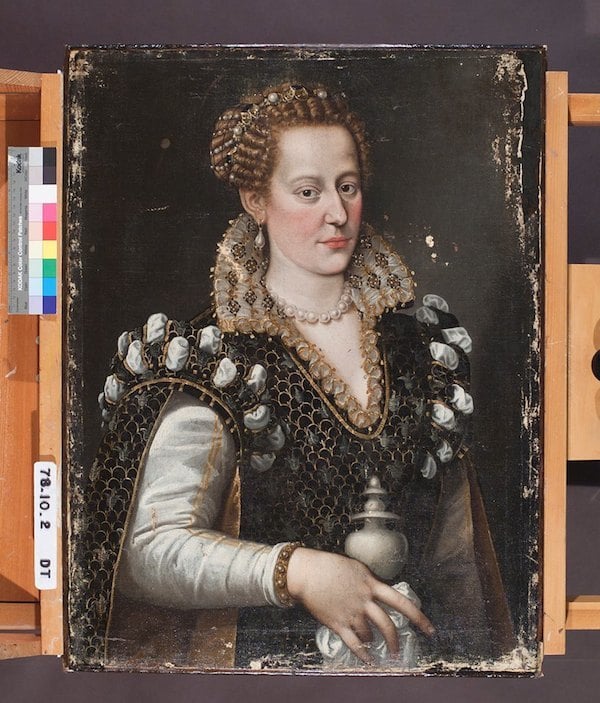
Courtesy of Carnegie Museum of Art.
Pittsburgh’s Carnegie Museum of Art was convinced that a supposed 16th century Bronzino painting was a modern fake, and was ready to jettison the canvas from its collection, when conservators discovered that the work was authentic, but had received a dramatic makeover during the 19th century, reports the Art Newspaper.
Originally identified as a Bronzino painting of Eleanor of Toledo, who married into the Medici family, the portrait looked more like the artwork on a Victorian biscuit tin lid than the output of the Italian Mannerist. Lulu Lippincott, the CMA’s curator of fine arts, convinced that the piece was no Old Master, passed it along to chief conservator Ellen Baxter, asking the conservation studio to confirm that it was a fake.
Immediately, Baxter noticed that the cracks on the surface of the painting were not consistent with the normal patterns for a work on canvas. There was, however, a metal stamp on the painting’s stretcher from a major British art restorer of the 19th century named Francis Leedham, known for his skill in transferring panel works onto canvas. The crack pattern matched that of a panel painting, leading Baxter to conclude that the piece had been transferred, likely due to an irreparable split in the panel.
This discovery was Baxter’s first indication that all was not what it seemed with the comely portrait. An X-ray analysis was the real breakthrough, revealing a far less flattering likeness underneath the painting’s surface: an older, droopy-eyed, jowly woman with meat hooks for hands. The 19th century over painting, likely done to make the less-than-attractive portrait easier to sell, also obscured a halo around the sitter’s head and an alabaster jar in her hands, two references to Mary Magdalene.
Pre- and post-restoration views of Isabella de’ Cosimo I de Medici (circa 1570–74), attributed to Allesandro Allori.
Courtesy of Carnegie Museum of Art.
With Baxter’s detective work done, Lippincott began tracing the provenance of the painting, which entered the CMA collection in 1978, in an attempt to identify the artist and the sitter. The work once belonged to Collis Potter Huntington, a 19th century art collector who made his fortune in railroads and left most of his collection to New York’s Metropolitan Museum of Art.
Lippincott honed in on the distinctive looking dress, which had been left as-is by the overzealous over painter, as she continued her research. While looking through other portraits of women in the Medici family, she spotted the garment in a Alessandro Allori work depicting Isabella de Medici (1542–76), Eleanor of Toledo’s daughter with Cosimo de’ Medici.
The story of Isabella is a tragic one, making the Magdalene imagery quite appropriate. Scandalously, Isabella was known to have had an affair with Troilo Orsini, cousin to her husband, Paolo Giordano. Lippincott believes the painting dates to around 1574, the year Isabella’s father died.
The new head of the family, Isabella’s brother Francisco, disapproved of her affair, which could explain the Magdalene references in the painting. “This may have been Isabella’s attempt to clean up her act,” Lippincott told TAN. Unfortunately, it was too little too late, as Isabella died only two years later, likely strangled by her husband at her brother’s request.
While her life ended tragically, the tale of the painting has a happier resolution, as Baxter has been able to return the painting to its original appearance—a less difficult process than you might expect. “I removed 130-year-old paint on top of 400-year-old paint, and you can’t get much more stable than that,” she told TAN.
Detail of Isabella de’ Cosimo I de Medici (circa 1570–74), attributed to Allesandro Allori.
Courtesy of Carnegie Museum of Art.
“Now that we have the picture as close to its original appearance as we can, scholars will be able to make an accurate assessment of its quality and authenticity,” Lippincott said. She expects the artist is someone in Allori’s circle, as he was the leading Medici court painter during the 1560s and 70s.
The dressed-down painting that was so close to being removed from the CMA’s collection is now on view at the museum as part of the exhibition “Faked, Forgotten, Found: Five Renaissance Paintings Investigated.” Isabella may be less glamorous than she was pre-restoration, but now she’s authentic.
“Faked, Forgotten, Found: Five Renaissance Paintings Investigated” is on view at the Carnegie Museum of Art, 4400 Forbes Avenue, Pittsburgh, June 28, 2014–September 15, 2014